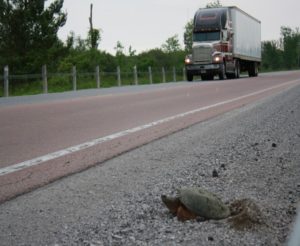
Snapping turtle nesting on the roadside
Our Ontario turtles are semi-aquatic; while they spend a lot of time in the water, they also travel on land a lot too. They will be on the move any time from April to October, although the busiest time for them is May and June. Both males and females travel, and both are equally vulnerable to road mortality (the OTCC consistently sees 50:50 males to females in all species except the map turtle).
Females travel the most in June, as this is their most important time for laying eggs. They look for appropriate sites to lay their eggs, and often travel large distances to find them. Each species has their own preference and preferred time for laying eggs. Laying eggs involves the female digging a hole (very slowly, in true turtle style!) and depositing the eggs, and then covering them up. There is no parental care of the eggs beyond this, and the hatchlings are on their own to find their way to water. Unfortunately, they don’t always choose the best site…
Turtle eggs act as food for a great many wild species, and only a very small percent (less than 1%) ever make into the population. In fact, it takes about 59 years for a snapping turtle to have a hope of replacing itself in the population, since they mature so late, and so few eggs survive!
While populations can sustain this loss of eggs and hatchlings when no other unnatural threats are placed on them, all of our Ontario species are now considered Species at Risk, due to the many human-related threats. As a result, they need all the help they can get to attempt to offset this. Many conservation initiatives are underway across the province, to help tip the balance back and allow populations to survive.
While protection of the adults is obviously the most important conservation initiative, additional programs also can help to augment populations.

